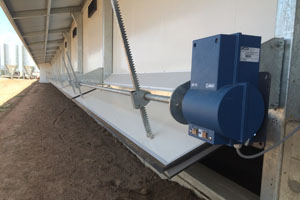Skov to supply giant free-range broiler facility

Danish poultry housing specialist, SKOV, has entered into an agreement to supply complete ventilation systems and farm management for 42 houses with free-range broiler production in Blanchetown, Australia.
The agreement includes complete Combi-Tunnel ventilation systems to a farm of seven production sites, each of them comprising six houses. A total of 42 houses, making it the largest free-range production in the world.
The farm, which is situated north of Adelaide in Blanchetown, South Australia, is owned and operated by Santrev Pty Ltd which is primarily known for construction of poultry houses in Australia and Asia. Production of free-range broilers is carried out for Inghams Enterprises Pty Ltd.
“Santrev has been our partner for many years and we have supplied ventilation systems and farm management to many of their livestock house construction projects for conventional broiler production over time,” says area sales manager Arne Overgaard, SKOV.
The focus on free range production of broilers has increased across the world in recent years which means that there is also an increased focus on production systems for free-range broilers.
“Quite recently, SKOV has developed and tested a new ventilation principle for free-range production. From a ventilation viewpoint, the challenge lies in having an open production environment, where we do not have full control of the livestock house environment,” continues Overgaard.
The SKOV system is fully automatic and can open and close doors (pop-holes) providing access to the free-range areas. The system primarily applies natural ventilation when the broilers occupy the free-range areas and ventilates according to the Combi-Tunnel principle when the broilers are inside the livestock house and the doors are closed.
“It will, in many cases, however, also be necessary to ventilate mechanically when the doors are open, as there may for example still be a great number of birds inside the livestock house. When that is the case, we regulate the climate in the livestock house based on the temperature of the air as well as humidity and CO2 levels,” concludes Overgaard.
Exhaust units positioned in the roof construction are applied for air outlet. This ensures that the system can provide natural ventilation for a great deal of the time when the doors are open. But it is also possible to open the wall inlets and ventilate mechanically via fans in the exhaust units. Furthermore, the livestock house climate is adjusted using high-pressure cooling.
The first twelve livestock houses, each with a capacity of approximately 40,000 free-range broilers, are under construction and they are expected to be built and commissioned within the next eighteen months.













